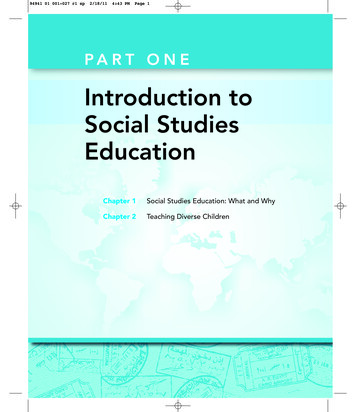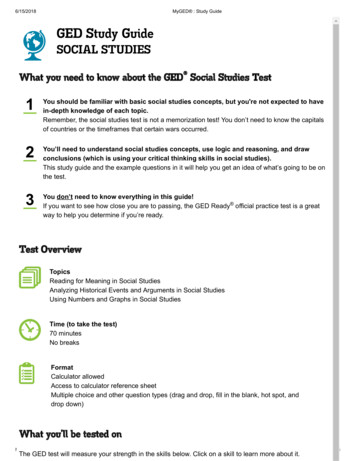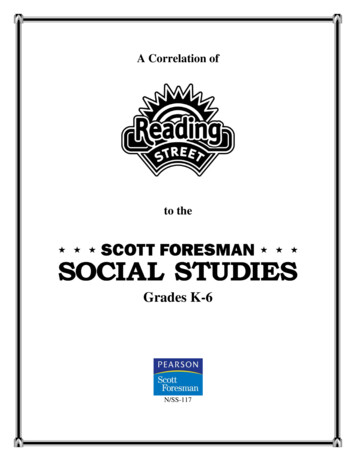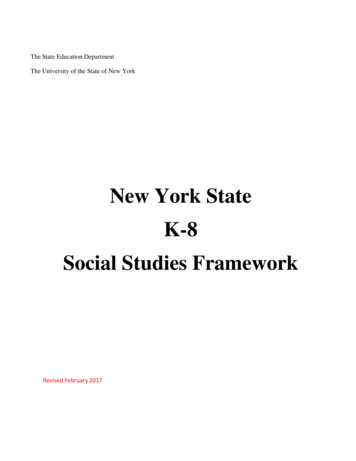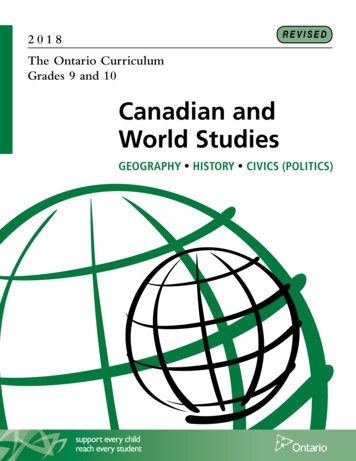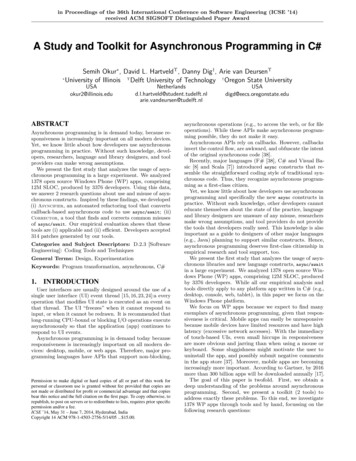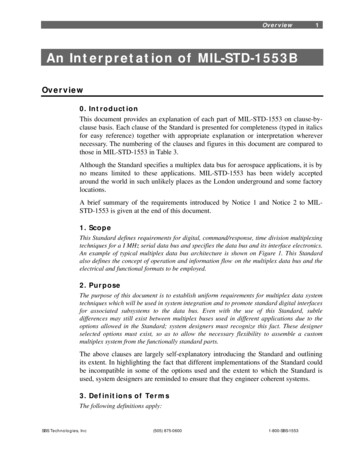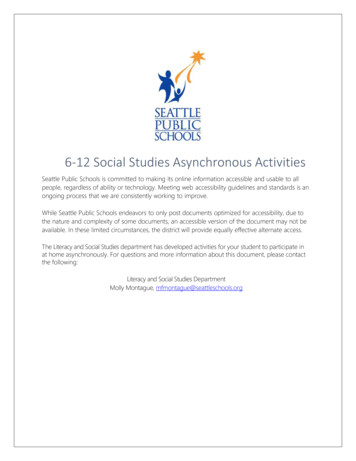
Transcription
6-12 Social Studies Asynchronous ActivitiesSeattle Public Schools is committed to making its online information accessible and usable to allpeople, regardless of ability or technology. Meeting web accessibility guidelines and standards is anongoing process that we are consistently working to improve.While Seattle Public Schools endeavors to only post documents optimized for accessibility, due tothe nature and complexity of some documents, an accessible version of the document may not beavailable. In these limited circumstances, the district will provide equally effective alternate access.The Literacy and Social Studies department has developed activities for your student to participate inat home asynchronously. For questions and more information about this document, please contactthe following:Literacy and Social Studies DepartmentMolly Montague, mfmontague@seattleschools.org
The Battle of Adwa10th Grade Social Studies World HistoryThese lessons were adapted from the Stanford History Education Group Reading Like a Historian materials.
On March 1, 1896, a massive Ethiopianarmy routed Italian forces at the Battle ofAdwa. The battle marked the largest militarytriumph of an African state over a Europeanarmy in the 19th century and helped Ethiopiaretain its independence during Europe’s“scramble for Africa.” In this three-day lessonyou will read three different textbook accountsof the battle – two American and one Ethiopian– to investigate the question: How didEthiopia defeat Italy at the Battle of Adwa?
The Battle of AdwaThis is a painting of theBattle of Adwa, whichwas paintedby an unknownEthiopian artist. Theexact date of thepainting is alsounknown. The battlewas fought betweenEthiopia and Italy onMarch 1, 1896. It lastedone day, andwas a decisive victoryfor Ethiopia.Painting of Battle of Adwa3
The Scramble for AfricaThe battle was significantbecause it marked thebiggest African victory overa European army in the19th century. The battlehelped keep Ethiopia, orAbyssinia, one of the onlyparts of Africa to remainindependent during the“scramble for Africa” in thesecond half of the 19thcentury – a time whenEuropean powersestablished colonies acrossmost of African continent.Adwa4
Central Historical QuestionHow was Ethiopia able to defeatItaly at the Battle of Adwa?
First Textbook Account
Ethiopian Independence“Only the African nation of Ethiopia was able toretain its independence by matching Europeanfirepower. In 1889 the emperor of Ethiopia,Menelik II, undertook a program of modernizationthat included a modern Army.In 1895, Italian forces invaded Ethiopia over atreaty dispute. Within a year, however, Menelik’sforces – more numerous and better armed thanthe Italians – defeated the Italians at the Battle ofAdwa.” (p.760)World History Textbook, 20067
First Textbook Account QuestionsAfter reading the first textbook account, answer the following questions: What is the source? How long is the passage? Why is this important? How does the textbook account help you answer the researchquestion: How was Ethiopia able to defeat the Italian army at theBattle of Adwa and stay independent?8
First Textbook Account Possible Responses What is the source?– The excerpt comes from an American, World History Textbook publishedin 2006. How long is the passage? Why is this important?– The passage is short, so it might not have a lot of detailed information. How does the textbook account help you answer the researchquestion: How was Ethiopia able to defeat the Italian army at theBattle of Adwa and stay independent?– This excerpt doesn’t say much because it is so short, but it does say thatEthiopia won because it had a bigger and better army.9
Your TaskHistorical Research Question: How was Ethiopia able to defeat theItalian army at the Battle of Adwa and stay independent? You will read 2 more different textbook accounts, 1 American and 1Ethiopian. You will compare and contrast – or corroborate – information across thesedifferent textbooks. Finally, you will use the texts to answer the historical research question.10
Day 1: Read and Respond Read Documents A and B Answer the Guiding Questions Print the “Battle of Adwa Student Materials” PDF orread the documents on the next slides and answer thequestions on a separate sheet of paper.11
Document A: American TextbookEthiopia: A Successful ResistanceEthiopia was the only African nation that successfully resisted theEuropeans. Its victory was due to one man – Menelik II. He becameemperor of Ethiopia in 1889. He successfully played Italians, French,and British against each other, all of whom were striving to bring Ethiopiainto their spheres of influence. In the meantime, he built up a largearsenal of modern weapons purchased from France and Russia. In1889, shortly after Menelik had signed a treaty with Italy, he discovereddifferences between the wording of the treaty in the Ethiopian languageand in Italian. Menelik believed he was giving up only a tiny portion ofEthiopia. However, the Italians claimed all of Ethiopia as a protectorate.Meanwhile, the Italian forces were advancing into northern Ethiopia.Menelik declared war. In 1896, in one of the greatest battles in thehistory of Africa – the Battle of Adowa – Ethiopian forces successfullydefeated the Italians and kept their nation independent. After the battle,Menelik continued to stockpile rifles and other modern weapons in caseanother foreign power challenged Ethiopia’s liberty.Source: Beck, R. B., Black, L., Krieger, L.S., Naylor, P.C., Shabaka, D.I. (2006)Modern world history: Patterns of interaction. McDougal Littell. p. 349.
Guiding QuestionsAm erican Textbook1. Who, according to this textbook, w as most responsible for the Ethiopian victory?2. What event led to the battle?3. Who, according to this account, started the w ar?4. Why, according to this account, did Ethiopia w in the battle?5. How is this account similar to and different from the first textbook account?
Document B: Ethiopian TextbookForeign Relations with ItalyMenelik had very close relations with foreign nations, especially with Italy.The relationship between Italy and Ethiopia began as a friendly one, but itdeteriorated after the Treaty of Wuchale was signed between them in1889. The cause of the conflict was Article XVII of the Wuchale Treaty,which was written differently in Amharic and Italian. The Amharic versionsays that Ethiopia could use the services of Italy in her foreign relationswith Europe. The Italian version bound Menelik to make all his foreigndecisions through Italy. Menelik asked Italy to change the Italian versionof Article XVII. Italy refused. As a result, Menelik rejected the entiretreaty. Thus, when peaceful methods of trying to occupy Ethiopia failed,the Italian government began preparation to occupy Ethiopia by force. In1895, the Italians invaded Ethiopia in the north. In the same year, 1895,Menelik declared war on Italy and marched northwards to fight theItalians.The Battle of Adwa (1896)The Battle of Adwa was fought in March 1896 between the Ethiopianarmy commanded by Menelik and the Italian army commanded byGeneral Baratieri. The battle was started by the Italian commanderBaratieri because he was given orders by the Italian prime Minister Crispito start the war quickly.The battle began at dawn on March 1, 1896. The battle lasted for one fullday. The result of the battle was unexpected and surprising to the world.The well-trained and well-armed Italian force was defeated by the illtrained and not well-armed Ethiopian force. Ethiopia was victoriousbecause of her people’s high degree of courage and the full support ofthe people. Moreover, Ethiopian women supplied water and arms to thefighters. They carried the wounded to camps and encouraged the fightersto fight with great courage.Source: Mehari, Getachew , Mamo, A., Alemu, T., T’Giorgis, S., & Dissassa, M.(2006). Social studies student textbook: Grade 8. Addis Ababa, Ethiopia:Educational Materials Production and Distribution Enterprise. p. 86-88.
Guiding QuestionsEthiopian Textbook1. According to this account, w hat events led to w ar between Ethiopia and Italy?How is this version similar to and different from textbook A?2. Who, according to this account, started the battle? Why did they start thebattle?3. Why, according to this account, did Ethiopia w in the battle? How does thiscompare to the other accounts?
End Day 1
Begin Day 2
Day 2: Make a ClaimCentral Historical Question:How was Ethiopia able to defeat the Italian army at the Battle of Adwa andstay independent? Reread your answers from yesterday. Write a response to the central historical question using evidence fromthe documents.18
Making a Claim :How did Ethiopia defeat Italy at the Battle of Adwa?Write or type your response, using evidence from the documents to supportyour claim.NameDateCourseHow did Ethiopia defeat Italy at the Battle of Adwa?
End Day 2
Begin Day 3
Day 3: Read More to Extend Your LearningWebsites: 124 years ago, Ethiopian men and women defeated the Italian army in theBattle of Adwa. Quartz Africa Battle of Adwa Britannica Ethiopia wins the battle of Adwa African American Registry Battle of Adwa (Adowa), 1896 Black PastVideos: How did Italy Lose to Ethiopia? (1895) Animated History Ethiopia celebrates defeat of Italian forces in the Battle of Adwa SABCNews22
Thinking Like a HistorianSelect 1 or 2articles or videosabout the Battleof Adwa andrespond to thesourcing andcontextualizationquestions.23
Sourcing & Contextualization FormatFor each additional resource you researched: Hand write or type your responses. Include the title of the article, the author’s name (if available) and thetitle of the website. Sourcing Questions:––––Who wrote this?What is the author’s perspective?When, where why was it written?Is it reliable? Why or why not? Contextualization Questions:– When and where was this document created?– What was different then? What was the same?– How might the circumstances in which the document was created affect itscontent? Reflect: How does this additional information add to yourunderstanding of the events of the Battle of Adwa?24
10th Grade Social Studies World History These lessons were adapted from the Stanford History Education Group Reading Like a Historian materials. On March 1, 1896, a massive Ethiopian . World History Textbook, 2006. 8 First Textbook Account Questions After reading the first t

